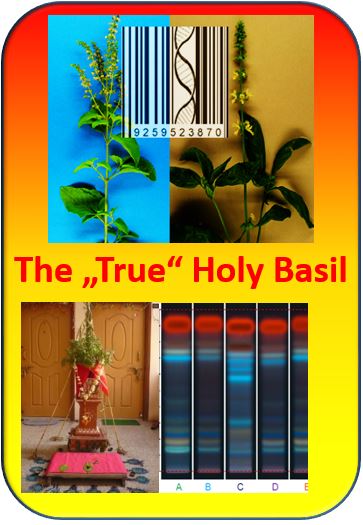2018_04 "True" Tulsi
Botanical Globalisation – challenges for consumer safety
The role of nutrition for health has shifted into the focus of public attention over the last years. An ageing society facing a progressively stressful work day will fuel this trend. So called functional food, often proclaimed as „Superfood“ creates novel and booming markets. Traditional plant names are often shaped by their use. In the context of their original culture, it is mostly (but even there not always) clear, what they mean. When these plants are brought to Europe and, thus, shifted out of focus, misunderstandings are predetermined.
The Tulsi Case - Holy Basil
The discrepancy between scientific and vernacular nomenclatures can be demonstrated exemplarily for Holy Basil or Tulsi (Ocimum tenuiflorum). This plant, central to Ayurveda, is now also popular in the West as „adaptogen against stress" and sold for high price. Basil is probably the medicinal plant with the longest documented tradition, the first descriptions date back over 4000 years to the Vedic scripts. Over this long history of usage, a complex and often ambiguous nomenclature developed, which is linked with the different uses for Tulsi (also termed as Tulasi). With a yearly trade volume of 100 t alone for Basil oil, „Tulsi“ is an important trading good existing in different forms, with Rama Tulsi, Krishna Tulsi and Vana Tulsi being the most important. How these names have to be assigned taxonomically, is far from clear.
Our solution to the problem
Using different Genetic Barcoding markers and carefully validated reference plants from the Botanical Garden of the Karlsruhe Institute for Technology we investigated numerous species and forms of the genus Basil and were able to identify four so called haplotypes. Interestingly, Vana Tulsi did not belong to the species O. tenuiflorum, but represented a variant of a different species, O. americanum. Also with respect to active compounds, investigated by High Performance Thin Layer Chromatography, this form of Tulsi is clearly different. We developed a simple PCR-based gene test, where a procedure called RFLP generates a diagnostic banding pattern that tells immediately, whether a commercial product contains Vana Tulsi or "True" Tulsi.
Why is this important?
Basil is rich in so called chemotypes, i.e. forms where the aromatic oils are composed differently. Among those, there exist types producing methyl eugenol or estragol, compounds that are meanwhile considered as genotoxic and cancerogenic. Recently, Basil seeds have come into fashion in form of "Smoothies" under the name "Basil as Chia", "Basil-Chia" or even simply as "Chia". Our gene test can help to protect consumers against consuming these problematic types of Basil.
Veröffentlichung
138. Jürges J, Sahi V, Rios D, Reich E, Bhamra S, Howard C, Slater A, Nick P. Product Authenticity versus Globalisation - The Tulsi Case. PloS ONE, in press

